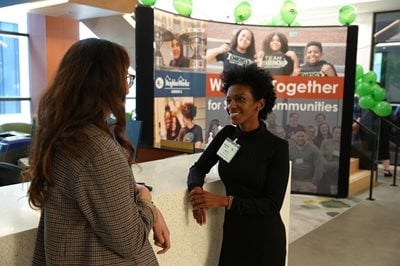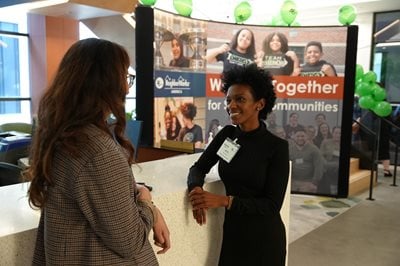Recently, I led NeighborWorks America's symposium, "Co-creating an Equitable Future at the Intersection of Health, Housing and Community Development."
Marietta Rodriguez presented this speech at the 2024 National Interagency Community Reinvestment on March 7 as part of a session entitled “A New Landscape for Community Impact.”
Imagine a neighborhood. ANY neighborhood. A neighborhood that you live in, a neighborhood that you grew up in or a neighborhood you've visited.
What does it mean to be rural? And is it overdue a change in perspective?
"We want people to think of rural as an asset," says Elena Kaye-Schiess, program manager, Rural Initiatives. "A lot of rural communities have to be self-sufficient in many ways. As a result of that, there's an opportunity to breed innovation and solutions to challenges."
 NeighborWorks America kicked off a yearlong observation of the organization’s 45th anniversary year this week, celebrating four and a half decades of partnerships and strengthening our communities.
NeighborWorks America kicked off a yearlong observation of the organization’s 45th anniversary year this week, celebrating four and a half decades of partnerships and strengthening our communities.
 NeighborWorks America kicked off a yearlong observation of the organization’s 45th anniversary year this week, celebrating four and a half decades of partnerships and strengthening our communities.
NeighborWorks America kicked off a yearlong observation of the organization’s 45th anniversary year this week, celebrating four and a half decades of partnerships and strengthening our communities.
Our Native Partnership Gathering, held during the NeighborWorks Training Institute in Chicago, was a chance for network leaders working with Native communities to learn from each other, to build relationships, to share strategies and – perhaps most of all – to talk story. One of my goals in the 15 months I've been director of Native American Partnerships and Strategy (NAPS) has been to help expand our investment and deepen our impact in Native communities.
During a Native-focused event at the recent NeighborWorks Training Institute (NTI), participants were quick to point out that if you’ve seen one tribe, you’ve seen exactly that: one tribe out of the diverse, 574 federally recognized tribes in the U.S. Their communities are diverse, too.
Over a dozen years, LIFT – which stands for Let's Invest for Tomorrow – has helped more than 25,000 people in 81 communities buy homes of their own by providing down payment assistance to
Staff at NeighborWorks Alaska have been buoyed by the results of the organization's supportive housing effort: More than 800 people, once experiencing homelessness, are now safely housed. Jim MacKenzie, executive director of the NeighborWorks nonprofit, wants to share the organization's strategy with other housing and community development organizations.

